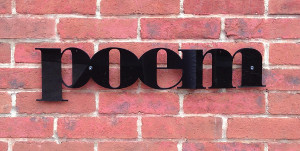This project, Laura Zorch, OPA Education Director explained to my class, was spectacular: loud, bright, and interactive. Jennifer Wen Ma's installation is entirely different.
"A Wintery Landscape" is a miniature forest with a pathway leading to a gazebo. All of the plants have been bathed in black Chinese calligraphy ink, and among the plants are small glass balls with LED lights situated underneath them, creating brief, small, points of light, or sparkle. This intimate, naturally protected space offers a stark contrast to the surrounding buildings, in particular the "evil empire...dragon containing" glass behemoth with multiple spikey points behind the square. But it is not an unbridgeable difference. It is a reminder of the green spaces scattered throughout the city, and the winding path a reminder of the three rivers that surround this strange, triangular urban space.
At the artist talk Wen Ma discussed some of her prior work. The first, a hanging garden of plants covered in black ink, meant to evoke cyclical changes in history, and reference the gardens of Babylon, was a sort of "3-d Rorschach", meant to emphasize the ephemerality of societies even at their height. But this work was not static. The plants continued to live, sending exploratory shoots of green out among the black, making it a study in growth and the will to life, what Baruch Spinoza calls "conatus" persistence in creating yet more life. Another notable piece was titled "Forty-four sunsets a day," a hanging installation that recreated the asteroid upon which The Little Prince lived. The work itself was circulating slowly, 44 rotations in a 24 hour period, such that the spectator would become slightly dizzy if they watched it over a long period of time. This asteroid, also black, had bushes sprouting above and below, subject to the same growth patterns that are unpredictable and destabilizing. Two contrasting pieces were a grass painting/planing that spelled out "AMOR FATI" ("Love fate," a reference to Frederich Nietzsche's time there as an invalid, but also his scholarly admission of acceptance, and love, of his own mortality) in San Maritz, Switzerland, and the other, an island with a pagoda in a river surrounding a favela in Brazil. These pieces, in places of extreme wealth, and point to the ways in which natural spaces can enliven and transform places that may already seem fixed, or too broken. In all of her nature installations she works with local plants, and local crafts people.
Turning to the Pittsburgh installation she reflected: "Winter is a time to store up...not every season is meant to be full of activity...we need fallow time, time to be quiet, reserved, and meditative." The Market Square installation is meant to facilitate such reflection. It is a four dimensional landscape painting (living and with the added dimension of temporality" in which residents can trace the process of getting ready for spring in watching the plants get ready for new life. The sparkles, she explained are "bits of creative energy...that get us through the hard times."
 |
| "A Wintery Landscape Cradling Bits of Sparkle." Photo credit: Market Square Public Art Program |
The black ink, she explained, after a student asked about it, is the "absence of light" but also is a "combination of all colors." It is "so pregnant with possibility but also powerful with its muteness." the color also was a choice Wen Ma made when she ewas in a period of depression, a kind of "black that is on you...that you can't shake," and the first time she washed the plants in it, she was unsure they would even survive, and yet, they continued to create new growth. "Life is tough, we all know what contemporary life is-- but if this plant could do it...you can succumb, or you could overcome."
Encountering the installation at night, during one of the coldest nights of Pittsburgh's winter, I moved quickly through the forest, and yet, did feel protected, cradled in velvet darkness made textured by glints of light. Wen Ma's reminder, that there are times for energetic output, and times to be "fallow" is a significant philosophical insight in our moment of flexible labor wherein every minute should be used well, maximized, and accounted for. What if every moment is not? What it, instead of marking success in how much is done, we find solace in cultivating readiness for energy, for creating space, quiet, the absence of speech? It is an idea that I find extremely (maybe paradoxically) comforting. What public art might create is a way to slow the impetus for frenetic creation. And that such slowness is necessary, even crucial, for creative thought and action. Sometimes the work of participatory public art is not to create more but just to create space for a pause.
The installation will be available for viewing until April 12, 2015, and will be changing with the seasons.




_-_Pitt_-_IMG_0573.jpg)